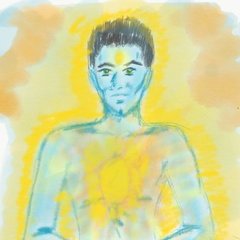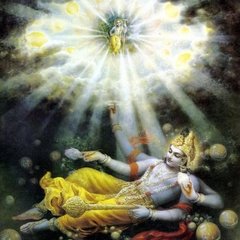Search the Community
Showing results for tags 'bhakti'.
Found 5 results
-
I used to do Naam Japa in the past recently this practice has become unacceptable to my mind. I can't find it logical. Though I have experienced it's mind purifying benefits yet it doesn't satisfy my logical mind. Is there any way I can do something other than Naam japa for mind purification. Let's say I take a word kindness and recite it every day with bhava and feelings. Won't it generate the same benefits as doing Naam japa. Will doing Naam japa provide any additional benefits than this self invented exercise of reciting the name of a quality?I understand that one-pointedness is the main goal of mantra or Naam japa but I want to achieve this without using any name of God. It would be great if you include reference to any guru who has touched this topic.
- 2 replies
-
- meditation
- naam-japa
-
(and 1 more)
Tagged with:
-
In a recent exchange with another bum on another thread, the topic of Sikhism came up. I have to admit I don't know much about it, albeit I've interacted with and had a few friends from that tradition, growing up in India. Here's what their primary motto/motif is (from Wikipedia) -- I say it's lovely!
- 8 replies
-
- 3
-

-
- sikhism
- nonduality
-
(and 1 more)
Tagged with:
-
The following is a twitter blog by Pradeep Apte called, "The Parabrahman." It consists of 221 tweets he put together. I've taken the liberty of correcting a few textual errors, and marking some divisions for easier reading. It's posted here in 4 sections... Please quote and comment freely. 1. With the grace of the Guru Sri Nisargadatta Maharaj, who is the “Sadguru Parabrahman”, Parabrahman tweets… 2. Right now, right here, while reading this, you are Parabrahman. The essence of Vedic science can be experienced directly and immediately. 3. As Parabrahman you are always there, yet unseen. Without the Sadguru’s teaching you can never ‘see’ yourself. 4. As these tweets proceed, always remember throughout that Parabrahman, Sadguru and the Guru Sri Nisargadatta Maharaj are all the same. 5. The direct teaching first, if you are spiritually mature enough to grasp it in one or few more re-readings, instantly you are Parabrahman. 6. The Guru says “You are Parabrahman and nothing else”. Accept it with great conviction and all that appears will seem to be palpably false. 7. I am the Parabrahman only! Adhere to this fundamental principle. 8. Accepting the Guru’s words with total conviction can transform your entire destiny, entire life. 9. The deep sense in you that ‘I am’ must accept that you are Parabrahman, not the mind. For that remain focused on the ‘I am’ without words. 10. By remaining focused or meditating on the ‘I am’ you become a witness to it and then, you stand apart as Parabrahman. 11. Only a non-illusory state can know the illusory state. The no-being state is the Parabrahman. 12. Brahman is manifest; Parabrahman is beyond or prior to that. Parabrahman is prior to consciousness or ‘I am’, it means the unborn state. 13. The eternal means: the Unborn. The truth is like that. The eternal is like that. 14. The one who recognizes all these time-bound stages is beyond time, is prior to time. Stay put there as the Parabrahman. 15. When knowing is transformed into not-knowing, that is liberation, you are Parabrahman. 16. Directly realize Parabrahman and finally know that nothing ever came to be. Thus rest in not-knowing with no need to know or read anymore. 17. Rare is the one bestowed with an extra-ordinary spiritual acumen to grasp the truth and realize Parabrahman at once or in a short while. 18. Such rare embodiments of truth, for the sake of the less fortunate ones, elaborate the teachings on Parabrahman as experienced by them. 19. We proceed with the teachings imparted by Sri Nisargadatta Maharaj through his dialogues using the Dasbodh by Swami Ramdas as a guideline. 20. The Dasbodh verse 51/sub-chapter 3/Chapter 8/ forms the very basis of the entire teaching of Sri Nisargadatta Maharaj. 21. “In the attributeless still expanse of Reality (Parabrahman) the inspiration ‘I Am’ arose. This is itself the primal illusion.” ------------------------------------------------------------------------------------------------------------------------------------- 22. Before elaborating on this, just for the sake of a new reader, or even the old one who wishes to brush up his fundamentals – a recap. 23. Knowledge means Self-knowledge where the Self sees only itself. This is called real or pure knowledge or “Jnana”. The Self is Parabrahman. 24. Primarily this means to know God. Knowledge is to reflect deeply upon the Eternal and the ephemeral and know one’s true “Self” (Swaroopa). 25. Nothing is found in the world as pure as Self-knowledge. As long as Self-knowledge is not clear everything is meaningless and useless. 26. The four stages towards Self-knowledge are, the Bound (Baddha), the Seeker (Mumukshu), the Aspirant (Sadhaka) and the Realized One (Siddha). 27. One can judge for oneself at which stage one is, only the One with Self-knowledge, the Siddha, can truly be said to be liberated. ------------------------------------------------------------------------------------------------------------------------------------- 28. Liberation, though a single step, is divided into four stages for understanding only: Swalokata, Samipata, Swaroopata, and Sayujya Mukti. 29. Swalokata means to live in the abode of God, Samipata means to live very close to God and Swaroopata means to appear like God. 30. In Sayujya Mukti one merges with God. It is ‘liberation as complete identification with the Self’, with no traces of any duality at all. 31. Liberation is a single movement of disappearance (of the false self or ego) and no clear boundaries can be drawn between these stages. 32. Understand well that the first three stages are reversible and one can fall back to old ways but Sayujya Mukti in irreversible and forever. ------------------------------------------------------------------------------------------------------------------------------------- 33. To acquire Self-knowledge or Parabrahman, meditation is the only way in which it can be done by the two main-stream teachings: Yoga and Vedanta. 34. In Yoga and Vedanta, meditation is a mental process by which the meditator becomes one with the object of meditation. 35. Concentration (dharana) is the preliminary stage, which when it becomes effortless and continuous takes the form of meditation (dhyana). 36. When the mind continuously flows towards its object, meditation culminates in total absorption (samadhi) in the object of meditation. 37. The sacred texts define concentration as one-pointed focus on any object, internal or external. 38. On focusing the mind uninterruptedly for twelve seconds on a specific object, we are said to achieve one unit of concentration. 39. Twelve such successive units of concentration make one unit of meditation, and twelve such successive units of meditation lead to Samadhi. 40. Concentration, meditation and absorption are the three depths of meditation which culminates in absorption into the object meditated upon. 41. The teachings of Sri Nisargadatta Maharaj and the Dasbodh are essentially of Vedanta, so the Yoga system is only briefly described here. ------------------------------------------------------------------------------------------------------------------------------------- 42. To attain the goal of Self-realization, the Yoga system employs an eight-fold system of practice consisting of eight steps or ‘limbs’. 43. The first five are restraint (yama), discipline (niyama), posture (asana), control of breath (pranayam) and withdrawal of mind (pratyahara). 44. The next three are concentration (dharana), meditation (dhyana) and absorption (Samadhi) already described in earlier tweets. ------------------------------------------------------------------------------------------------------------------------------------- 45. Meditation according to Vedanta is an intense form of worship (upasana) which eventually leads to the direct perception of Parabrahman. 46. The Vedantic practices for meditation are divided into two groups: foundational and structural. 47. In Vedanta, success in structural practices is proportional to the success in foundational practices. 48. The four foundational disciplines are: discrimination, dispassion, mastery over six virtues and intense longing for liberation. 49. Discrimination is between the real and the unreal and dispassion means giving up all desires, whether for this world or the next. 50. Of the six virtues to be mastered the first three are: control of mind, control of senses and withdrawal of mind from sense objects. 51. The next three to be mastered are: fortitude, faith in the words of the Guru and scriptures and concentration of the mind upon Brahman. 52. The essence of the six virtues is self-control, without which the quest for Self-knowledge is an empty dream. 53. Intense longing for liberation is most crucial as its intensity determines the achievement of the goal which is, Parabrahman. ------------------------------------------------------------------------------------------------------------------------------------- 54. The three steps of meditation in Vedanta are: hearing (shravana), reflecting (manana) and meditation (nididhyasana). 55. Hearing is listening to the teachings of the Guru, reflecting is thinking constantly on the teachings heard from the Guru. 56. Meditation is constantly doing the practice (sadhana) as prescribed by the Guru to the exclusion of all other ideas or thoughts. 57. Meditation practiced earnestly without interruption for a long time, with intense love for the chosen ideal, culminates in samadhi. ------------------------------------------------------------------------------------------------------------------------------------- 58. When Samadhi is with effort due to mental disturbances it is savikalpa, when these disturbances are absent it is nirvikalpa. 59. The immersion of the mind in the Self without its complete destruction (manolaya) is Kevala Nirvikalpa Samadhi. 60. With the mind destroyed (manonasa) and remaining permanently in the primal pure state without effort is Sahaja Nirvikapla Samadhi. -------------------------------------------------------------------------------------------------------------------------------------
-
Sri Ramakrishna Paramahamsa is an iconic figure in Modern Indian history and in the Revival of Hindu Dharma, as well as popularization of Advaita Vedanta. His words and teachings have inspired millions of people over several decades in and outside of India. Enjoy... http://www.belurmath.org/gospel/
- 64 replies
-
- 3
-

-
- Sri
- Ramakrishna
-
(and 3 more)
Tagged with:
-
I've been reading some discussions that compare different approaches to the Spiritual quest. One camp seems to consider the intellectual inquiry method (aka Jnana Yoga) to be superior to others, while the other camp seems to prefer the body-mind-energy method (aka Raja Yoga). I bring up the four yogas because this topic has been addressed in the Bhagavad Gita a few thousand years back. The Bhagavad Gita covers four different approaches to the spiritual quest - The devotional way aka Bhakti Yoga, The action without desire way - aka Karma Yoga (which essentially is Wu Wei approach) The mind-body-energy way - aka Raja Yoga The intellectual inquiry way - aka Jnana Yoga If you read a good commentary on the Bhagavad Gita (or if you know sanskrit the original document), you will realize that all the four ways are considered equally good. Paradoxically, the translations of the verses on each way says "This < > way is the superior way". When one reads only one section, they might come back with the impression that, that specific way is preferred over others. However, when taken into context of reading the entire book, it will become evident that specific characteristics are also mentioned about the type of person who might benefit from any one approach over the others. It depends on the mental, energetic and physical make-up of the seeker and no one way is absolutely better than another...it all depends
- 19 replies
-
- 3
-

-
- yoga
- bhagavad gita
- (and 4 more)



